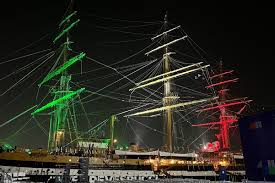 India’s stand at the WTO negotiations on signing up the Trade Facilitation Agreement (TFA) may have greatly disappointed the US. In his recent visit to New Delhi, the US Secretary of State John Kerry said so.
India’s stand at the WTO negotiations on signing up the Trade Facilitation Agreement (TFA) may have greatly disappointed the US. In his recent visit to New Delhi, the US Secretary of State John Kerry said so.
WTO was established in 1995 under the Marrakech Agreement and replaced the General Agreement on Trade and Tariffs—( GATT) that began in 1948 in Geneva. Standing by the side of Lake Geneva, it is an imposing building which seems formidable from the outside. Inside, passports are taken away from visitors by the security and a visitor from developing country feels quite alien and vulnerable in the strictly western ambience.
While the logic of setting up the WTO was to lay down rules of trade between nations, its main proponents, the US and the EU, wanted greater access to the markets of developing countries. The setting up of a ‘rule book’ unfortunately has been sabotaged by India recently but perhaps with good reasons. The WTO has claimed that with TFA signed, there would be a big gain of $1 trillion for the world economy and there would be 21 million jobs created with around 18 million jobs created in developing countries. How such figures have been arrived at is not very clear.
India has been objecting to the TFA on grounds that it has to undertake stock piling of food grains and provide food for the very poor at lower than market prices. It also has to give production subsidies to poor farmers. In Bali in December 2013, it was agreed by the EU and the US that India could go ahead and stockpile food procured at subsidized prices and no legal actions or sanctions would be imposed on it till 2017 by which time a solution would have to be worked out.
The Modi government has rightly disagreed to sign the TFA on the grounds that the 2017 deadline is too short a time for undertaking any significant adjustment. Basically, the whole TFA is tilted towards the rich countries and private sector traders.
India’s Food Security Act binds the government by law to provide food to its vulnerable and poor population. In order to do so, it buys grains from farmers at minimum support prices. The US and others argue that since India buys food grains from Indian farmers at administered prices which are above market prices, it leads to a trade distorting agricultural subsidy.
Under WTO’s Agreement on Agriculture, the difference between the administered price and the market price is considered a subsidy and there is a limit on how much is permitted. The US has argued that India’s expanded food security programme exceeds its limit and constitutes a trade distorting subsidy since the government could then dump its surpluses on international markets. India’s support prices are only slightly higher than current Indian market prices, but they appear much higher because, according to AoA stipulation, the administered prices should be compared to the average international prices in 1986-88. These are roughly one sixth of current market prices and so any procurement price that the government pays today looks like a huge subsidy.
It is important thus to reopen the AoA as being asked by the G33 (like minded countries which now are 46 in number) since 2006. The G33 has been asking for an update of the reference price on account of inflation in the past three decades. The US and others have refused and now even after Bali when there was a commitment to resolve the issue of the base price, India and G33 have seen no change in the food security issue while the developed countries are pressing for trade facilitation measures.
While the developed countries are keen to promote TFA which will involve high costs for the developing countries without the benefits flowing in automatically, the main issue of the bias against the developing countries in the provision for food security has not been resolved. The costs will include upgradation of infrastructure, change of customs procedures and port facilities.
At present, only the exporters’ from developed countries seem to be in the forefront pressing for TFA. Also when India signs the TFA, certain agreements on reduction of import duties would have to be undertaken which could lead to a huge influx of imports which could lead to a widening of the trade deficit especially when in India’s case, exports have been growing slowly.
The US and the EU should understand the reason why India is trying to stick to its position of support to poor farmers. The EU spends 39 billion euros in giving direct subsidies to farmers and the US spends around $20 billion to its farmers in direct subsidies. The catch is that in developed countries, the direct subsidies are easy to give and administer as all farmers are literate with bank accounts. In India’s case, the scene is different and requires indirect subsidies which are seen as price and trade distorting.
But giving huge amounts of cash subsidies in the developed countries is also a controversial issue and many economists have argued that by lowering the actual cost of production artificially, these countries have produced mountains and lakes of agricultural products which are then dumped in international markets which lower the prices. As Mark Mallock Brown, former head of the UNDP estimated : “It is the extraordinary distortion of global trade where the West spends $360 billion a year on protecting its agriculture with a network of subsidies and tariffs that costs developing countries about US $50 in potential lost agricultural exports. ”
The US gives direct payment subsidy to farmers without regard to the economic need of the recipients or the financial conditions of the farm economy. The US has such a strong farm lobby that the government refused to cut subsidies in 2006 at the Doha round of WTO talks to a level where other countries’ non subsidized exports would be competitive, thus stalling the talks.
India, however, is under pressure and could be isolated in its stance and may relent by September 2014.
The views expressed in this article are solely those of the author.
(Courtesy: ORF)
Author Profile
- India Writes Network (www.indiawrites.org) is an emerging think tank and a media-publishing company focused on international affairs & the India Story. Centre for Global India Insights is the research arm of India Writes Network. To subscribe to India and the World, write to editor@indiawrites.org. A venture of TGII Media Private Limited, a leading media, publishing and consultancy company, IWN has carved a niche for balanced and exhaustive reporting and analysis of international affairs. Eminent personalities, politicians, diplomats, authors, strategy gurus and news-makers have contributed to India Writes Network, as also “India and the World,” a magazine focused on global affairs.
Latest entries
 India and the WorldNovember 26, 2025G20@20: Africa’s Moment – The Once and Future World Order
India and the WorldNovember 26, 2025G20@20: Africa’s Moment – The Once and Future World Order DiplomacyOctober 4, 2025UNGA Resolution 2758 Must Not Be Distorted, One-China Principle Brooks No Challenge
DiplomacyOctober 4, 2025UNGA Resolution 2758 Must Not Be Distorted, One-China Principle Brooks No Challenge India and the WorldJuly 26, 2025MPs, diplomats laud Operation Sindoor, call for national unity to combat Pakistan-sponsored terror
India and the WorldJuly 26, 2025MPs, diplomats laud Operation Sindoor, call for national unity to combat Pakistan-sponsored terror India and the WorldJuly 25, 2025When Fire Ends, Diplomacy Begins
India and the WorldJuly 25, 2025When Fire Ends, Diplomacy Begins







